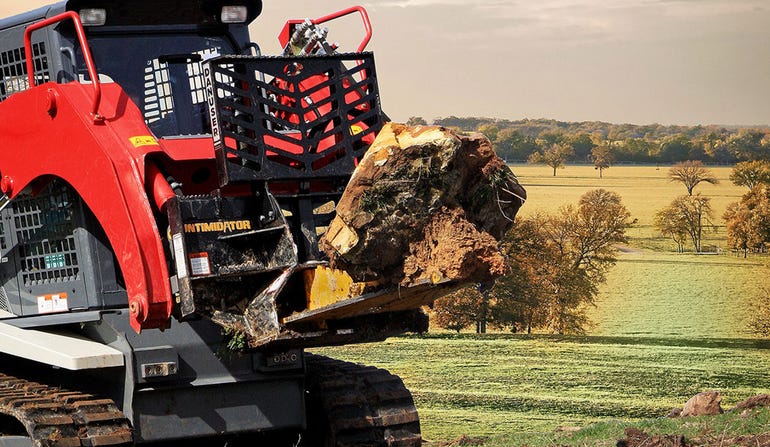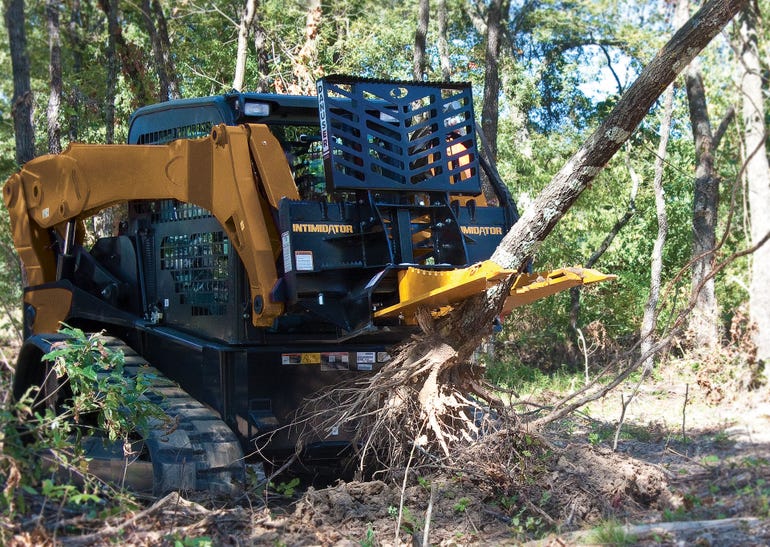March 1, 2018

Sponsored Content
When imagining equipment work in the Stone Ages, one might picture Fred Flintstone using his dinosaur to pick up rocks at the Slate Rock and Gravel Company quarry at the beginning of every Flintstones’ episode. Although these childhood memories are fun, they’re not an accurate reflection of early agricultural or industrial attachments.
Perhaps it started with a sore back. Since the beginning of time, humans have had a rich history of cleverly inventing designs in a variety of industries and applications to make their jobs easier. Humans have been using animals for backbreaking work for centuries. In the 19th century, steam power gained traction followed by gasoline and diesel-powered tractors. “The ability for the tractor to use implements and attachments was one of the biggest innovations to change modern farming,” says Glenn Danuser, co-owner of Danuser. “And over the years, attachments have helped make jobs easier on the farm and job site. And thanks to the introduction and advancement of skid-steers, excavators, backhoes and tractor front-end loaders in the 20th century, humans have been able to get work done faster and more easily than ever.”

Attachment Advances for Common Tasks on Livestock Operations
Fencing - Farming originated about 13,000 years ago along with fences to keep animals out of gardens and off of cultivated land. Mechanical diggers made their lives much easier. The first known auger appeared in the Iron Age (about 2,800 years ago), and the spiral-flighted auger appeared in the Middle Ages, made by a blacksmith. However, fencing in the 1800s was hard work for ranchers and farmers who had to dig post holes by hand. It wasn't until the 19th century, when factories started mass producing augers and other fencing attachments, that they became readily available.
“Today, ranchers and farmers are looking for more efficient ways to build a fence,” says Glenn. Augers and post drivers attach to the tractor, skid-steer, mini-excavator, loader or backhoe to eliminate strenuous labor, especially for bigger operations. For projects that require a lot of post holes, attachment manufacturers offer many options for hydraulic and PTO auger systems and mounts for various agricultural and industrial applications. Post drivers can drive anything from T-posts to railroad ties. Some even have a grapple option to pick up posts from the ground for one-person operation.
Land-Clearing - Before tractors and excavators, a popular way to clear land was the slash-and-burn method; another way was clearcutting and grubbing followed by the removal of stumps. This could be done with an ax, saw and a team of oxen or horses. After a tree was cut down, branches were chopped off, and the trunk placed aside. The stump might have been left in the ground for a few years to let it deteriorate, but eventually, the stump had to be grubbed. A grub ax was used to dig around stumps and cut off small roots. A pickax was used to cut off larger roots.
Then the stump puller was introduced. A long cable was purchased that the farmer would wrap around the stump using a horse to pull it. The horse would then pull the stump from the ground. Fast forward to today’s pickax: new material handling attachments that pull, saw, dig, and carry trees, shrubs, posts and rocks, such as the Danuser Intimidator. “Attachments, such as the Intimidator, are designed to perform a wide variety of tasks, from digging and cutting roots with replaceable bucket teeth to large tree and stump removal with vertical saw teeth, all in one tool,” Glenn notes.

Attachments Today: More Options and Versatility
Before the 1940s, each manufacturer used their own system for attaching their implements to a tractor. Eventually, manufacturers agreed on the three-point hitch as a standard hitch system. Today, almost every tractor manufacturer uses Harry Fergusson’s three-point linkage. “Standardizing the hitch meant attachments could offer more task solutions and options to get the work done on the farm or land, Glenn explains. “This also opened the door to making more attachment options available for more farmers and ranchers to increase productivity.”
Today’s tractors have a means to transfer power to augers, tree pullers, post drivers, concrete breakers and a whole host of attachments through PTO and hydraulic systems. Standardized hitches have evolved into standardized quick attach connections, making the transition from one attachment to another a breeze. This versatility provides farmers and ranchers more options to handle the toughest jobs using a skid-steer or tractor, efficiently and effectively.
Although dinosaurs became extinct before humans could use them to cultivate the land, it is undeniable that history does reveal humans will take whatever measures necessary to make their jobs easier and more efficient.
About the Author(s)
You May Also Like




